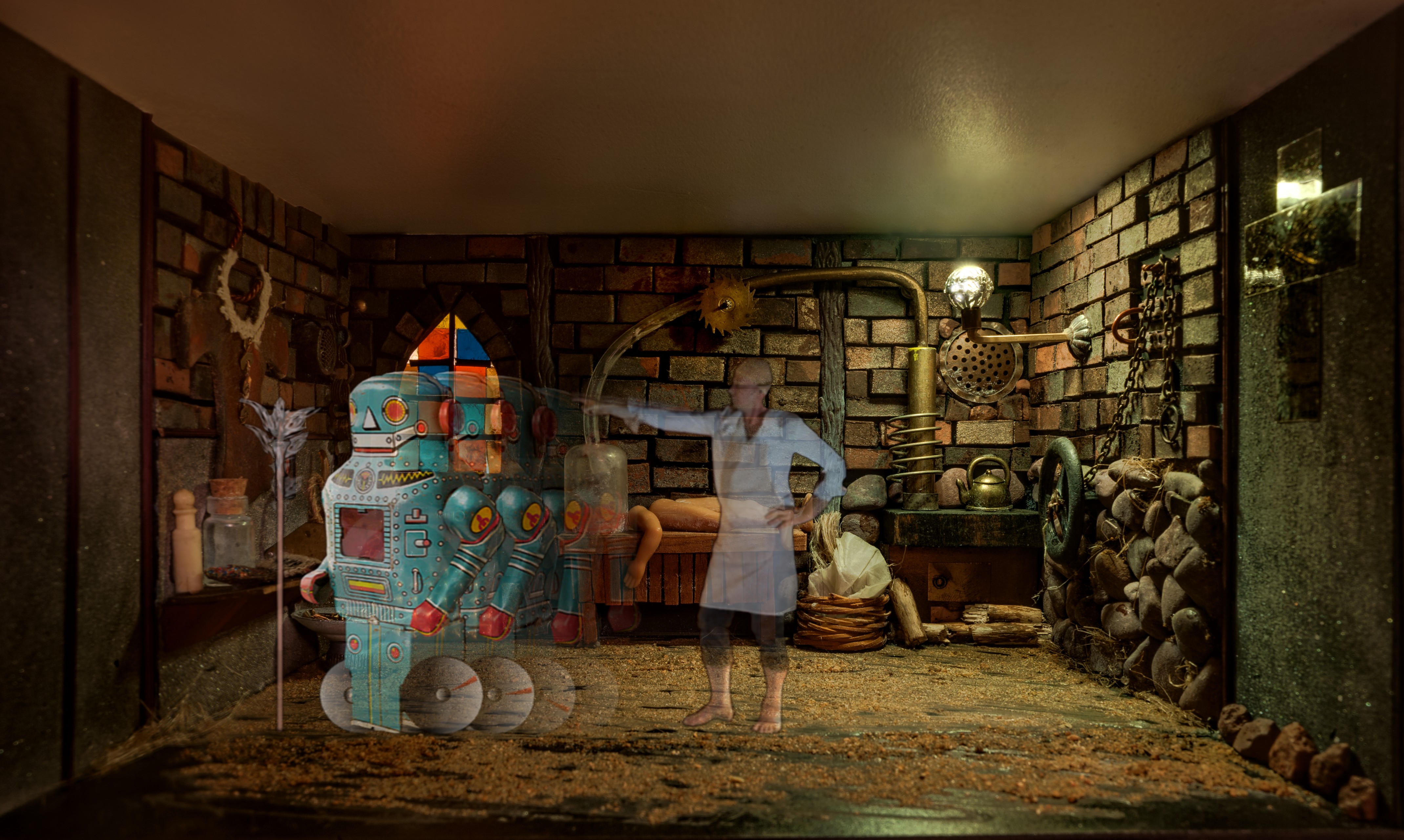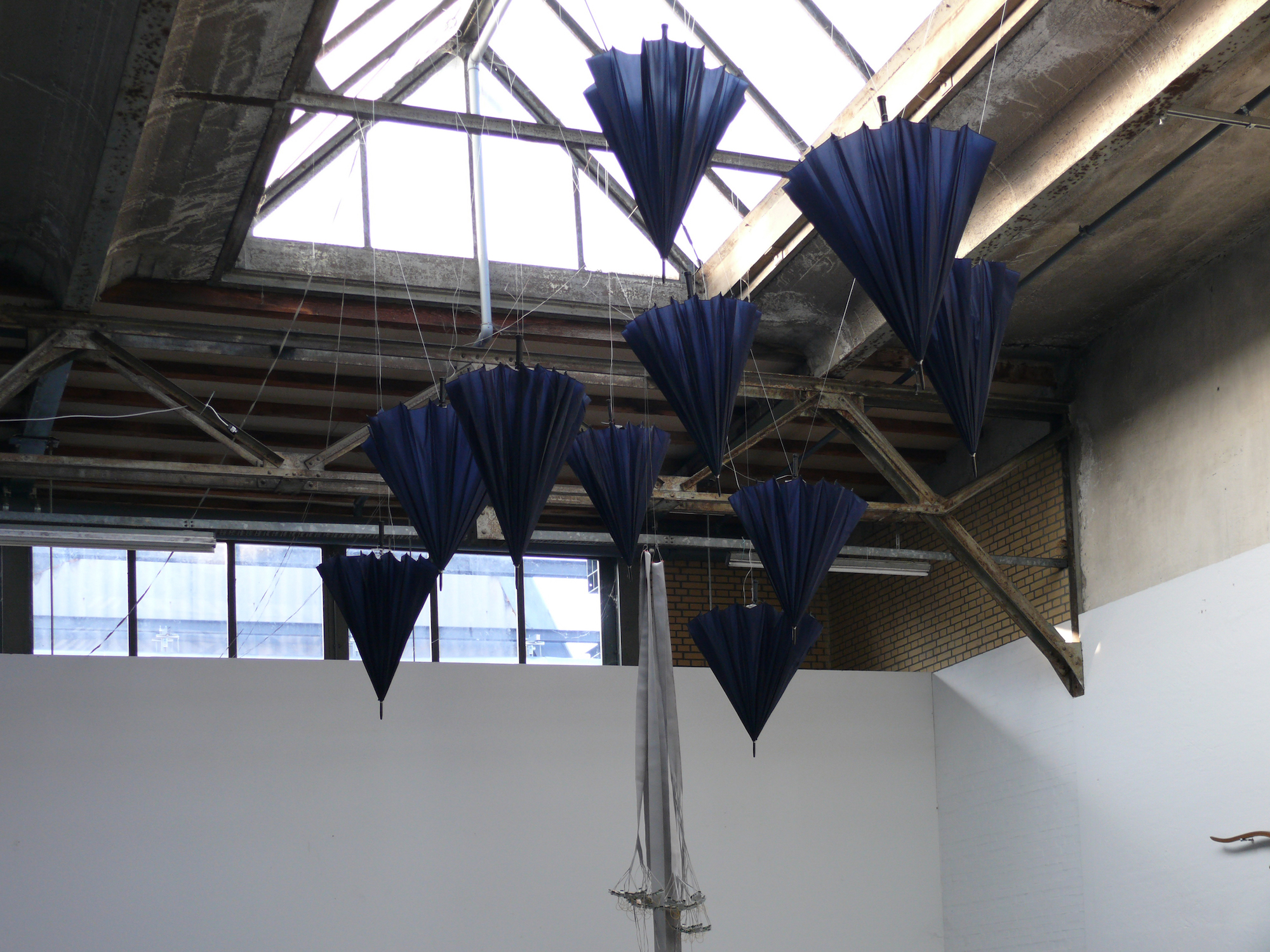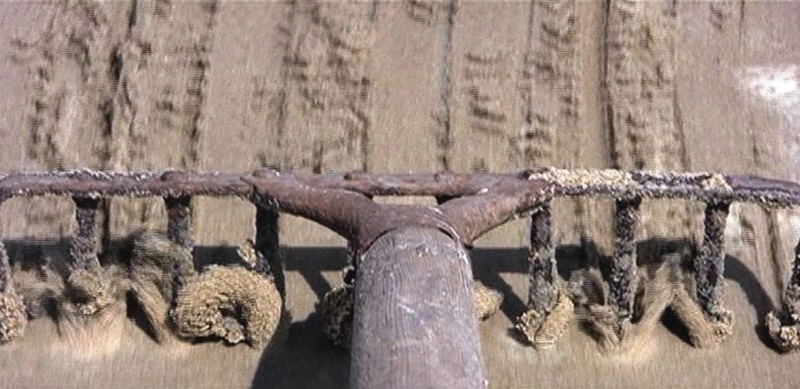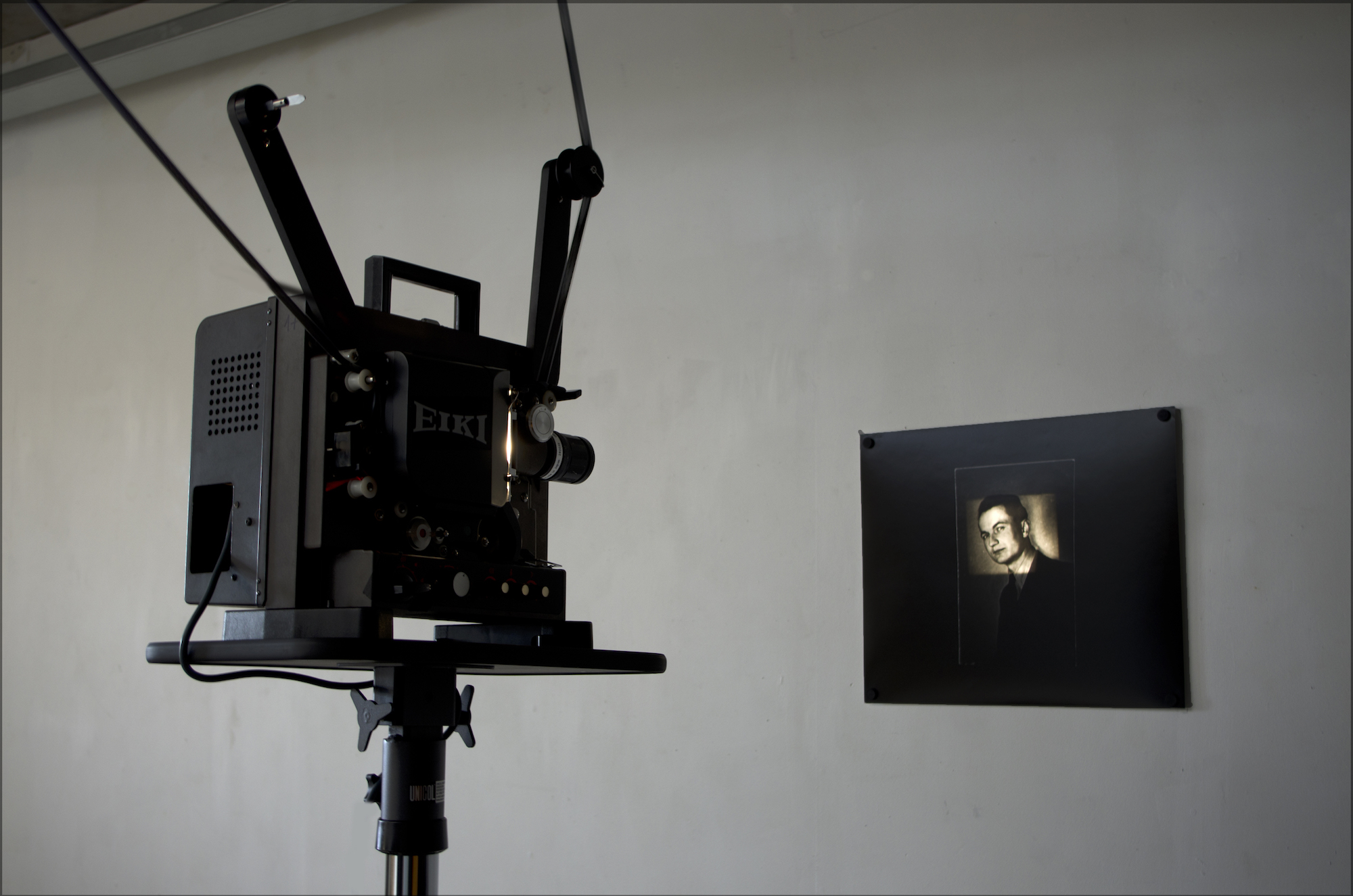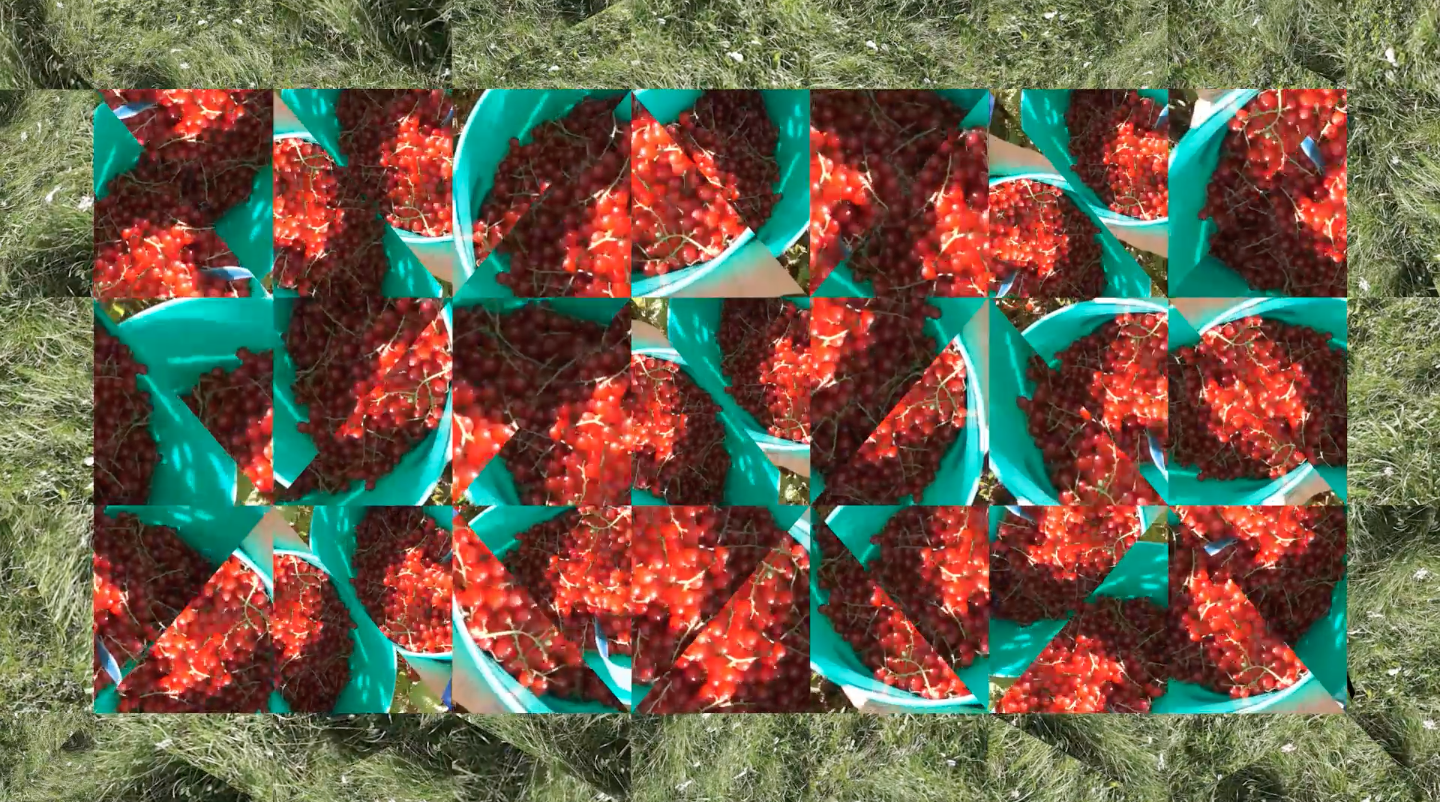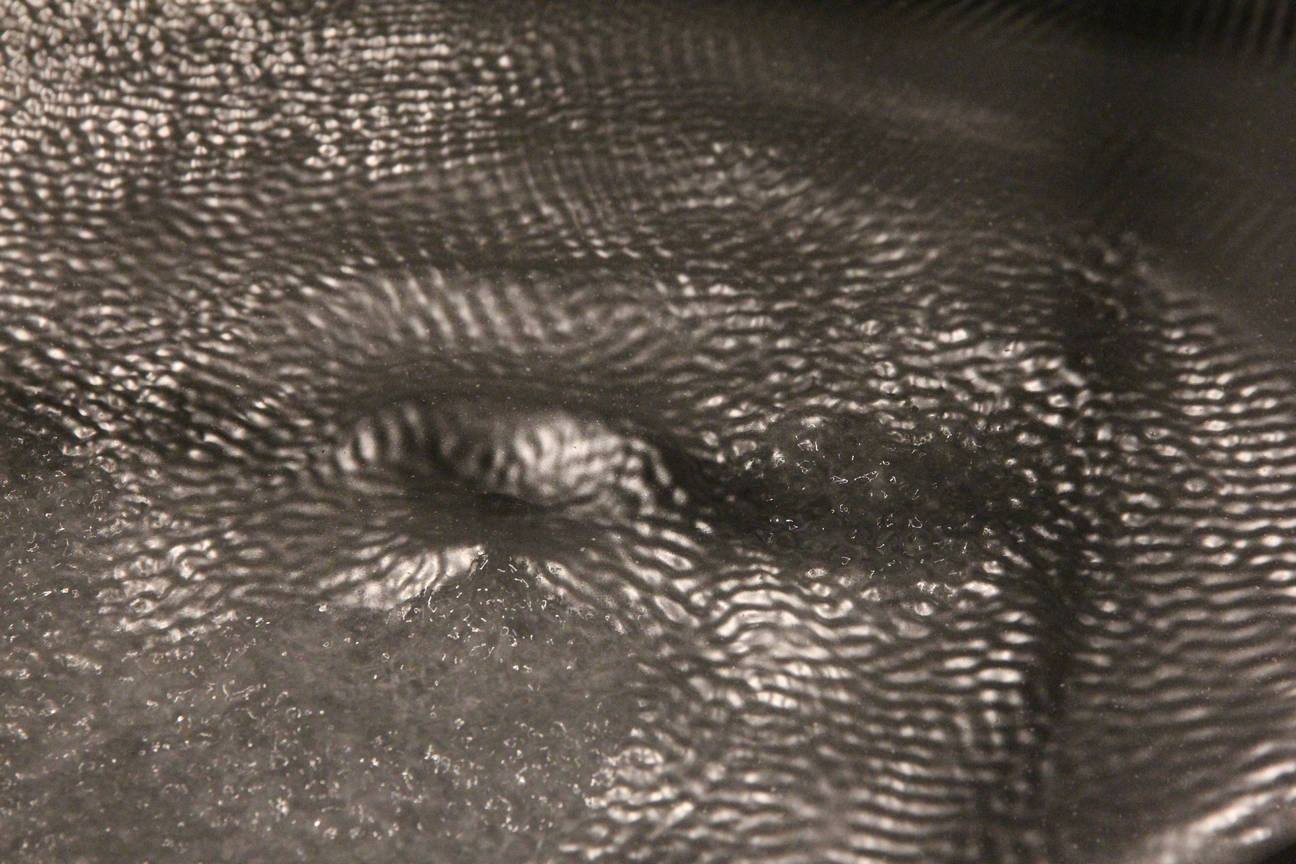CYFEST 2017: ABOUT FESTIVAL – PROGRAM – EXHIBITIONS – SOUND ART – EDUCATION – PARTICIPANTS – OPENING HOURS AND TICKETS – PRESS AND REPORTS – CONTACTS
“Participation Effect”
Curated by Anna Frants (Russia-USA), Varvara Egorova (Russia)
January 26 — February 6
St. Petersburg Stieglitz State Academy of Art and Design (Museum of Applied Arts)
St. Petersburg, Solyanoy per., 13–15
Opening night, photography by Anton Khlabov
Technologies in art gave the viewer an opportunity to feel that which seemed unrealizable — the participation effect. The participation effect is when we remember that mother smelled of milk, moss was warm and prickly in summer, and a sunray that had drowned in the carafe danced on its wall as a small rainbow…
Vladimir Nabokov called this an «individual mystery». It does not have the time of birth or the time of sunset; it cannot be explained by biology, mathematics or physics; it lives in the eternity and obeys only its owner.
It is absolutely unclear why the art that uses gadgets and software is still called «new» while not only it is not young — it dates back to the age of striking fire.
For instance, try telling a contemporary teenager about Rene Magritte and he would decide that the artist was working in the technique of augmented reality that is fashionable nowadays. However, I am not going to argue, an excessive fascination with gadgets is akin to light in the eyes of a Cro-Magnon looking at the beads.
So what will ensue from this? That which artists tried to attain for ages, that which was analyzed by ranks of art historians, that to which French Art Academy appealed in 19 th century and that which Duchamp mocked has finally become possible?
Oh, come on…
And here is Nabokov again, from his early poem of 1923:
And it took place at world’s beginning:
A savage who’s still semi-mute,
His soul is seeing, but not winged,
He’s shaggy, light and he’s not skewed,
He noticed, swinging up his bow,
As mountain eagle upwards flew,
How rich it was — the siren note
Of arrow that he just threw.
Anna Frants
Participants:
Marina Alekseeva turns standardization into a game field. In her lightboxes, the transfiguration of a standard takes place all the time. The viewer is first filled with admiration to recognize a familiar thing, and then with delight to discover, thanks to one or two details, how surreal this familiar thing is. Any object in its habitual place here can unexpectedly demonstrate its freedom from the stereotypes of behavior and perception.
Marina Alekseeva
Artist. Born in 1959 in Leningrad, USSR. By education, she is a ceramist, graduated from the Vera Mukhina Higher School of Art and Design (Leningrad, USSR). Works in various media: installation, object, painting. Participant of the Moscow Biennale of Contemporary Art (2011), Panama Biennale of Contemporary Art (2013). Winner of Sergey Kuryokhin Award (Russia, 2010) in the nomination “Art in Public Space” (together with Boris Kazakov). Her works are in the collections of Russian Museum (St. Petersburg, Russia), Moscow Museum of Contemporary Art (Russia), Multimedia Art Museum (Moscow, Russia), Ekaterina Cultural Foundation (Moscow, Russia), Fundació Sorigué (Lleida, Spain), Art Vectors Investment Partnership (Vienna, Austria) and others. Lives and works in St. Petersburg, Russia.
Staircases are probably the only city spaces that have not been subjected to the strong impact of time. Faзades change, interiors change, but staircases remain unchanged. While we wait for somebody, we look through the peephole. This is inextricably linked to expectation, apprehension and curiosity. In this work, however, what we see in the peephole does not look like regular visitors. It is the identifying code for Wi-Fi waves, and there is no need to look through the peephole in order to allow them into one’s home. Wi-Fi here is an image of the internet, an image of modern life in the “clouds”, in different spaces simultaneously; it is an assertion of the smooth cyber-evolution of the human being.
Ludmila Belova
Artist, curator. Born in 1960 on the Kamchatka Peninsula, USSR. Graduated from the Abramtsevo Art and Industry School (Moscow Region, USSR). She works with video, sound, painting, photography. Investigates the issues of memory, space and time; studies the impact of new technologies on the human being in art practices; makes the viewer a participant of the art process through interactivity. Works of Ludmila Belova were exhibited in Europe, USA, Russia and Asia. Participant of the Moscow Biennale of Contemporary Art (Russia, 2005, 2011), exhibitions parallel to Venice Biennale (Italy, 2011, 2013, 2015), parallel program of the Manifesta 10 Biennale (St. Petersburg, Russia, 2014). Winner of the prize “50 Bestern” ZKM (Karlsruhe, Germany, 2000), nominated for Sergey Kuryokhin Award (Russia, 2011, 2015). Her works are in the collections of Russian Museum (St. Petersburg, Russia), Anna Akhmatova Museum (St. Petersburg, Russia), Erarta Museum (St. Petersburg, Russia), The Kolodzei Art Foundation (New York, USA), in private collections in Switzerland, Germany and Russia. Lives and works in St. Petersburg, Russia.
www.ludmilabelova.com
In Peter Belyi’s opinion, the experience of life in Russia often involves aesthetic compassion. We could always turn away from a gloomy view, walk on by, or run home from our car, leaping over puddles. But if we stop for a moment, the brutal aesthetics and philosophy of life catch up with us almost instantly, like magic rays. This is not the first time that Peter Belyi has addressed the theme of aesthetic compassion. Applying Matyushin’s principle of “expanded vision”, he peers at Russia, generalizing visual experience, examining the intrinsic relationship between delicate light and the rough surfaces of steel and concrete, making the alienation zone the chief topic of his objects.
Peter Belyi
Artist, curator. Born in 1971 in Leningrad, USSR. In 2000, received a Master’s Degree from Camberwell College of Arts (London, UK). Actively works in the field of large-scale installation. Monumentality in his projects is coupled with visual asceticism, deliberate use of rough materials, brutality of the approach — with lyricism of the conceptual message. Participant of numerous exhibitions in Russia, Europe and USA. His works are in the collections of Russian Museum (St. Petersburg, Russia), Victoria and Albert Museum (London, UK), Margulies Collection at the Warehouse (Miami, USA) and others. Winner of Sergey Kuryokhin Award (Russia, 2009) in the nomination “Best Work of Visual Art”. Lives and works in St. Petersburg, Russia.
www.peterbelyi.com
In Ryan Wolfe’s installation, a mechanical sculpture articulates from afar the artist’s breathing and heartbeatin real time. The rhythm of the artist’s breathing materializes in the opening and closing of suspended umbrellas as his heartbeat appears as pulses of fluttering lights. Linking the creator to the creation, sensor devices monitor the artist’s physical system, generating data which is transmitted by Bluetooth / cellular wireless and a microcontroller interfacing from anywhere to the installation site. “Pneuma” explores the ephemerality of life, the relationship of modern science to mortality, and questions the future of physicalityby turning absence into presence, synchronizing life in one location to another space.
Ryan Wolfe
Artist. Born in the USA. He uses his hybrid background in art and technology to design interactive systems reminiscent of — yet completely separated from — the natural systems upon which they are based. Wolfe’s work has been shown in the Hermitage Museum (St. Petersburg, Russia), Oriental Pearl Tower (Shanghai, China), E-Halle (Basel, Switzerland), Dovzhenko Film Studios (Kiev, Ukraine), Artplay (Moscow, Russia), Sky Gallery 2 (Tokyo, Japan) and other top venues around the world. In 2016, Wolfe became the first tech based artist selected to do an installation for London’s iconic Great Eastern Wall. Lives and works in San Francisco, USA.
Engineer: Alexey Grachev
Supported by CYLAND MediaArtLab
When the viewer’s shadow is cast on a wall of cardboard boxes for storing things, it turns on the sounds of a ticking clock. The more shadows, the louder and more varied the ticking; the personal time of each one flows into one sound stream. When all the visitors leave together with their shadows, the universe falls silent and time stops… Time exists because of us; it is but a shadow of what we are…
Elena Gubanova
Artist, curator. Born in 1960 in Ulyanovsk, USSR. Graduated from the Ilya Repin State Academy Institute of Painting, Sculpture and Architecture (Leningrad, USSR). She is engaged in painting, sculpture, installations, and video. Gubanova’s principal interest as an artist is to explore the time-space notion in a social context and to present scientific discoveries through the figurative language of art. Recipient of Sergey Kuryokhin Award (Russia, 2012) in the category “Best Work of Visual Art” (together with Ivan Govorkov). Her works were exhibited at major Russian and foreign venues, including Hermitage Museum (St. Petersburg, Russia), Russian Museum (St. Petersburg, Russia), Museum of Moscow (Moscow, Russia), University Ca’ Foscari (Venice, Italy), Chelsea Art Museum (New York, USA), Kunstquartier Bethanien (Berlin, Germany). Participant of the Manifesta 10 Biennale Parallel Program (St. Petersburg, Russia, 2014) and several exhibitions parallel to Venice Biennale (Italy, 2011, 2013, 2015); many times participant of the Cyfest Festival. Since 1990, she has been working in collaboration with Ivan Govorkov. Lives in St. Petersburg, Russia.
www.elenagubanova.com
Ivan Govorkov
Artist. Born in 1949 in Leningrad, USSR. Graduated from the Ilya Repin State Academy Institute of Painting, Sculpture and Architecture (Leningrad, USSR). He is engaged in philosophy, psychology, painting, drawing, sculpture and installations; he works at the junction of traditional art and cutting-edge technologies. Professor of drawing at the Ilya Repin Institute. Recipient of Sergey Kuryokhin Award (Russia, 2012) in the category “Best Work of Visual Art” (together with Elena Gubanova). His works were exhibited at major Russian and foreign venues, including Hermitage Museum (St. Petersburg, Russia), Russian Museum (St. Petersburg, Russia), Museum of Moscow (Moscow, Russia), University Ca’ Foscari (Venice, Italy), Chelsea Art Museum (New York, USA), Kunstquartier Bethanien (Berlin, Germany), Sky Gallery 2 (Tokyo, Japan). Participant of the Manifesta 10 Biennale Parallel Program (St. Petersburg, Russia, 2014) and several exhibitions parallel to Venice Biennale (Italy, 2011, 2013, 2015); many times participant of the Cyfest Festival. Since 1990, he has been working in collaboration with Elena Gubanova. Lives in St. Petersburg, Russia.
The basis of Ronald Dagonnier’s installation is a sound dialog extract from the movie “Crime andPunishment” directed by Lev Kulidzhanov (1970) based on the eponymous novel by Fyodor Dostoevsky. The work involves video mapping on a motorized 3D-print.
Ronald Dagonnier
Artist. Born in 1967 in Messancy, Belgium. Focused on digital art and video, he has participated in numerous exhibitions including those in the Russian State University for the Humanities (Moscow, Russia), Galerie Axiolotl (Toulon, France), Aeroplastics Gallery (Brussels, Belgium) and the Naval Museum (Venice, Italy). Currently he teaches Videography and Digital Arts at the Higher School of Arts in Liège (ESAVL, Belgium). Lives and works in Liège, Belgium.
www.ronalddagonnier.be
A screen divides an exhibition hall in two parts. Images projected on the screen imitate a mirror. At first approach, visitors see their own reflection. An interactive carpet lies in the middle of the floor. When they step on it, a signal is sent to a computer to record the visitor for 30 seconds and to store the image in the installation database. After this, they not only see themselves in the “mirror”, but previous visitors as well. This installation reacts to the visitor’s presence on the interactive carpet by superimposing various images, scenes and sounds generated at random. The show evolves throughout the exhibition; it changes as more visitors are added to its database.
Alexandra Dementieva
Artist. Born in 1960 in Moscow, USSR. Studied journalism and fine arts in Moscow (USSR) and Brussels (Belgium). Her principal interest as an artist is the use of social psychology, perception theory and behaviorism in her installations as well as the development of film narration through the point of view of a subjective camera. She has been an active participant of the CYLAND Media Art Lab since 2008. Professor at the Royal Academy of Arts (Brussels, Belgium). Dementieva received the first prize for the best monochannel video at VAD Festival (Girona, Spain). She is a participant of numerous exhibitions in major Russian and international cultural institutions, including Hermitage Museum (St. Petersburg, Russia), Moscow Museum of Contemporary Art (Russia), Centro de la Imagen (Mexico City, Mexico) and others. Lives and works in Brussels, Belgium.
www.alexdementieva.org
From the series “Skins of Conceptual Constructions”
Software and control system: Valery Karpov, Dmitry Dobrynin
Philosophers create concepts, slowing down extracted fragments of the chaotic field, and “Skins of Conceptual Constructions” is the reverse acceleration of concepts up to their return to the graphic… The object is offered to “take a look” at a page with text. For a certain time it analyzes the information, and then it comes into motion. The more the text is absorbed with concepts, the longer and more varied the object’s activity. The most animated fragments shoot bright liquid. Yellow, blue, red matter flows out of the apertures. The construction gradually splatters itself and the area underneath with splashes and jets of color. Pure colors mix and create a complex palette.
Dmitry Kawarga
Artist. Born in Moscow, USSR. Received an artistic-technical education. Most significant of his works in the recent years are based on the synthesis of art and technologies. These are interactive kinetic objects of science art and installations created in cooperation with scientists, computer programmers and engineers. Kawarga calls himself a «biomorphic radical». Constant participant of international exhibitions and festivals of contemporary technological art, such as Lexus Hybrid Art (Moscow, Russia, 2012), Ars Electronica (Linz, Austria, 2013), FILE (São Paulo, Brazil, 2014) and others. Lives and works in the Greater Moscow Area, Russia.
www.kawarga.ru
Generated by “Mutator” software
Software development: Stephen Todd, Lance Putnam
“Mutator” shows synthetic 3D organic forms evolving as projected computer animation and in real time in VR. The viewer is navigating through a vast multidimensional space of possible forms.
William Latham
Artist, computer scientist. Born in 1961 in the UK. Originally trained as an artist at the Oxford University (UK) and the Royal College of Art (London, UK). Well known for his evolutionary art created from 1987 to 1993 whilst a Research Fellow at the IBM Scientific Centre in Winchester, UK. His pioneering organic art based on the concept of “evolution by aesthetics” was shown widely in major touring shows in the UK, Germany and Japan in the 90s. From 1993 to 2003 he worked in Rave Music and computer games development working with Universal, Sony SCEE and Warner Bros. In 2007 Latham became Professor of Computer Art at Goldsmiths (University of London, UK) and returned to his artistic origins and restarted his long term collaboration with mathematician Stephen Todd. Since late 2015 he has worked extensively in VR developing “Mutator VR”. Lives and works in London, UK.
latham-mutator.com
In this digital creation of a spectacular display of flowers with a biblical painting hanging in the background, Lee Lee Nam illustrates the transience of beauty. The work was inspired by the Eastern proverb “hwa-mu-ship-il- hong” that literally means “the beauty of a flower never lasts ten days”, which resembles the Western concept of Vanitas.
Lee Lee Nam
Artist. Born in 1969 in Damyang County, South Korea. Graduated from Chosun University (Gwangju, South Korea). In his media artwork, which began attracting wide attention in the mid-2000s, the artist constructs a space where the physical and the virtual realm co-exist. He has held solo and group exhibitions in various countries including South Korea, Japan, China, Taiwan, Singapore, USA, UK, Spain and Tunisia. He was also selected to showcase his work at the “Personal Structures. Crossing Borders” exhibition at Palazzo Mora during the 2015 Venice Biennale (Italy). Lives and works in Gwangju, South Korea.
www.leenamlee.com
An installation consisting of two videos (“DH Sand”, “Rake”) playing side by side at the same timein continuous loops. Both videos were created during the artists’ residency iii (Studio Loos, The Hague,Netherlands) from material of the The Hague coast sand dunes and surroundings.
Phill Niblock
Composer, media musician, artist. Born in 1933 in Anderson, Indiana, USA. Since the mid-60’s Niblock has been making music and intermedia performances which have been shown at numerous venues around the world. Since 1985, he has been the director of the Experimental Intermedia foundation in New York, USA. As an intermedia artist he uses music, film, photography, video and computers. Much of his pieces are based on collaborations with specific musicians, including Susan Stenger, Robert Poss, Jim O’Rourke, Ulrich Krieger, Tom Buckner, and many others. Recipient of the John Cage Award (USA, 2014). Lives and works in New York, USA.
www.phillniblock.com
Katherine Liberovskaya
Artist. Born in 1961 in Montreal, Canada. Involved in experimental video since the 80s. Liberovskaya has collaborated with many composers and sound artists such as Phill Niblock, Al Margolis, Hitoshi Kojo and David Watson. Since 2003 she is active in live video mixing exploring improvisation with numerous audio artists. In addition to her art practice she has concurrently been involved in the programming and organization of diverse media art events in Canada, USA and Europe. Lives and works in Montreal, Canada, and New York, USA.
www.liberovskaya.net
Al Margolis
Sound artist, producer. Born in the USA. Since 1984 he has performed and recorded under the name If, Bwana. Collaborated with Pauline Oliveros, Joan Osborne, Monique Buzzarté, Adam Bohman, Ellen Christi, Ulrich Krieger, Dave Prescott and many others. Margolis is also known as an activist of the 1980s American cassette underground through his cassette label Sound of Pig, and is the co-founder of experimental music label Pogus Productions. In addition to his composition and improvisation work, he plays bass guitar in the legendary proto-punk band The Styrenes. Lives and works in New York, USA.
In this performance, Nao Nishihara shows the notion of his body. When he beats a drum on his back, he looks as if he is dancing even though he does not intend to dance. The drum makes him dance. So who is the boss of the body? Also, kinetic sound machines emit sound across him. When they are activated, he feels as if he’s in a band. The machines are machines, but they help him in the way musicians do. Besides, they do not always work perfectly and they require maintenance similar to the body. Nishihara wants to show the art of the normal body. Not for any nostalgic reason, but due to the further development of society and technology.
Nao Nishihara
Artist. Born in 1976 in Hiroshima, Japan. Active practitioner of sound art and performance. Inspired by dadaism and classical music of Japan he is known for building movement-animated, half-autonomous sound machines that explore the bodily aspect of creating and performing music in space. His recent solo and group exhibitions include Mori Art Museum (Tokyo, Japan), IDIO Soundlab (New York, USA), Kunstraum Kreuzberg/Bethanien (Berlin, Germany). Lives and works in Tokyo, Japan.
nishiharanao.blogspot.com
Original portrait by Omer Coene (1950)
This work tries to put new life into a still image. As if that were possible… A motion sensor makes the visitor activate the projector as soon as he or she takes a closer look at the photo. One angle to the screen reflects the direct still image, and a second angle slightly to the left or right reflects the moving image. By a gentle rocking movement of the spectator in the rhythm of the projector’s motor, the portrait comes to life, as if a new dialogue could be started. This installation seeks to recall the primary possibilities and probabilities of film seen as a moving image.
Els van Riel
Artist. Born in 1965 in Belgium. Studied photography and cinematography, worked as a photographer, editor and producer for various photo, film, video and theater productions. Her films, videos and installations explore the impact of detailed changes in movement, matter, light and perception. Lives and works in Brussels, Belgium.
www.elsvanriel.be
This video is made on the basis of patchwork technique, where patches of cloth are replaced by video fragments. A “living” carpet, which combines the past and the present, is a work that raises the question — where is our reality? For most of the time we are not “here and now”, but rather in the past or planning thefuture, dreaming or fearing it. This video reminds us of our memory: a piece of one event or another, all of them at the same time: winter, summer, children’s drawings painted in ’85, where one demonstration is followed by another in the struggle for “peace”, numerous butterflies — real and not real, the portrait of Pushkin that could be found in almost every household, and various other images. This endless game of reality-unreality reflects our ability to move not only in space but also through time (especially in the past and the present) when a certain smell, taste, color or light evoke a memory and allow a transition into another space-time.
Veronika Rudyeva-Ryazantseva
Artist. Born in 1981 in Krasnoyarsk, Russia. Graduated from the Stieglitz State Academy of Art and Design (St. Petersburg, Russia) and Pro Arte Institute (St. Petersburg, Russia). In her work, she doesn’t limit herself to one media, combining video, painting, installation and drawing. Relegates herself to the “children of perestroika” generation; studies human being, identity issues and daily absurdity, ties between past and present. Participant of numerous exhibitions in Russia and abroad including such venues as the Winzavod Contemporary Art Center (Moscow, Russia), Russian Museum (St. Petersburg, Russia), Korjaamo Gallery (Helsinki, Finland), Linden Museum (Stuttgart, Germany). Her video work “Purification by Snow” is acquired into the collection of State Center for Contemporary Art (Moscow, Russia). Lives and works in St. Petersburg, Russia.
This is an exploration of heat within the different modalities of the term. In terms of human sensibilities it is a proposition to see it as an agent organizing intimacies and the experience of space. But heat is of course also very much about energy and entropy — notions with a multitude of connotations, with infinite space for metaphorization.
Ayatgali Tuleubek
Artist, curator. Born in 1985 in Zhambyl, Kazakhstan. Graduated from the Oslo Academy of the Arts (Norway). Co-curator of the Central Asian Pavilion at the 55th Venice Biennale (Italy, 2013, together with Tiago Bom). Tuleubek has presented solo exhibitions at UKS (Oslo, Norway, 2011) and Malmøgata Fine Arts Project Space (Oslo, Norway, 2011). He has also been included in group exhibitions at the 3rd Moscow Biennale for Young Art (Russia, 2012) and the Delhi International Arts Festival (New Delhi, India, 2010). Lives and works in Oslo, Norway.
The electromagnetic field of 50 Hz frequency is generated by an inductor coil and presented as an object in space. The project invites the viewer to rethink the relationship between the human being and the anthropogenic environment. In the contemporary world, human beings often find themselves in zones of magnetic fields generated by a power grid without a sensory experience of them. The inductor coil is a concentrated presence of the electric grid that has filled every corner of the civilized ecumene. The installation manifests the invisible presence of electromagnetic field by means of objects that emit sounds or move under its influence. What transpires proves to be a dance and a sound performance, a duet of the body and the field.
Nazar Rakhmanov
Dancer, actor, artist. Born in 1991 in Russia. Graduated from the Center of Religions Studies at the Russian State University of Humanities (Moscow, Russia). He chose dance as his core activity. Participated in plastic performances at the Krug Studio that works with people with disabilities (Moscow, Russia) and then became an actor at the Poema Theatre (butoh, physical theater, Moscow, Russia). Together with Anastasia Tolchneva, Eduard Rakhmanov and Julia Borovaya, he organized the save.co.lab — a project of the SAVE laboratory for integration of science and performance art. In 2016, he became an actor at the Blackskywhite Theater (physical and visual theater, Moscow, Russia); he works on his own projects “spring_inception” and “Galvanization”. Lives and works in Moscow, Russia.
Eduard Rakhmanov (EduArt)
Chemist, artist, designer. Born in 1981 in Russia. Graduated from the chemistry department of the Moscow State University (Russia). Together with Julia Borovaya, he founded the SAVE laboratory; together with Julia Borovaya, Nazar Rakhmanov and Anastasia Tolchneva, he organized the project save.co.lab that integrates science and performance art. Participated in the projects for the exhibition at the Polytechnic Museum “Russia does it herself” (Moscow, Russia). Lives and works in Moscow, Russia.
Anastasia Tolchneva
Musician, artist. Born in 1992 in Russia. Participant of international projects in the field of contemporary dance. She created the musical projects Lovozero and Tikhie Kamni. Collaborates with media artists Julia Borovaya, Nazar Rakhmanov and Eduard Rakhmanov as part of the project save.co.lab that combines science art and performance. Lives and works in Moscow, Russia.
Supported by CYLAND MediaArtLab
Conceptually referencing a computer grid and visually reflecting the infrastructure of a building without walls, Anna Frants builds an open framework room. Comprised of raw polypropylene cubes, the exposed framework houses objects, videos, and movements. The interior (unlived-in lived-in) space is empty for viewers to navigate the visuals, sounds, words, and virtual actions of the exterior matrix and formulate their own story. Birds chirp, recorded faces communicate, playful toys whiz and whirl, the seas ebb and flow — each with brand names that they are sold as or known by as characters in Frants’ theatrically staged workand beyond. At first glance reminiscent of “The End” or “Mad Max”, this multimedia environment is less а scene from a dismal future and more an intimate setting presented for a poetic contemplation of the sense of self. The installation is flexible, varying from site to site and country to country, with local materials utilized each time.
Anna Frants
Artist, curator in the field of media art. Born in 1965 in Leningrad, USSR. She graduated from the Vera Mukhina Higher School of Art and Design (Leningrad, USSR) and Pratt Institute (New York, USA). Cofounder of the nonprofit cultural foundation St. Petersburg Arts Project, CYLAND Media Art Lab and Cyfest festival. Frants’ interactive installations have been showcased at Moscow Biennale of Contemporary Art (Russia), Video Guerrilha Festival (Brazil), SIGGRAPH Asia Conference (Hong Kong), Manifesta 10 Biennale (St. Petersburg, Russia, 2014), Museum of Art and Design (New York, USA), Hermitage Museum (St. Petersburg, Russia), Chelsea Art Museum (New York, USA), Russian Museum (St. Petersburg, Russia), Kunstquartier Bethanien (Berlin, Germany) and at other major venues all over the world. The artist’s works are in the collections of Russian Museum (St. Petersburg, Russia), Museum of Art and Design (New York, USA), Sergey Kuryokhin Center for Modern Art (St. Petersburg, Russia) and Kolodzei Art Foundation (New York, USA) as well as in numerous private collections. Lives and works in New York, USA, and St. Petersburg, Russia.
www.annafrants.net
About the curators
Anna Frants
Artist, curator in the field of media art. Born in 1965 in Leningrad, USSR. She graduated from the Vera Mukhina Higher School of Art and Design (Leningrad, USSR) and Pratt Institute (New York, USA). Cofounder of the nonprofit cultural foundation St. Petersburg Arts Project, CYLAND Media Art Lab and Cyfest festival. Frants’ interactive installations have been showcased at Moscow Biennale of Contemporary Art (Russia), Video Guerrilha Festival (Brazil), SIGGRAPH Asia Conference (Hong Kong), Manifesta 10 Biennale (St. Petersburg, Russia, 2014), Museum of Art and Design (New York, USA), Hermitage Museum (St. Petersburg, Russia), Chelsea Art Museum (New York, USA), Russian Museum (St. Petersburg, Russia), Kunstquartier Bethanien (Berlin, Germany) and at other major venues all over the world. The artist’s works are in the collections of Russian Museum (St. Petersburg, Russia), Museum of Art and Design (New York, USA), Sergey Kuryokhin Center for Modern Art (St. Petersburg, Russia) and Kolodzei Art Foundation (New York, USA) as well as in numerous private collections. Lives and works in New York, USA, and St. Petersburg, Russia.
www.annafrants.net
Varvara Egorova
Curator, project coordinator at CYLAND Media Art Lab. Born in 1965 in Leningrad, USSR. Graduated from the Vera Mukhina Higher School of Art and Design (Leningrad, USSR). Works at CYLAND Media Art Lab since its foundation in 2007. Participated in all the Cyfest festivals as a designer, organizer, curator of exhibition programs. Lives and works in St. Petersburg, Russia.




















